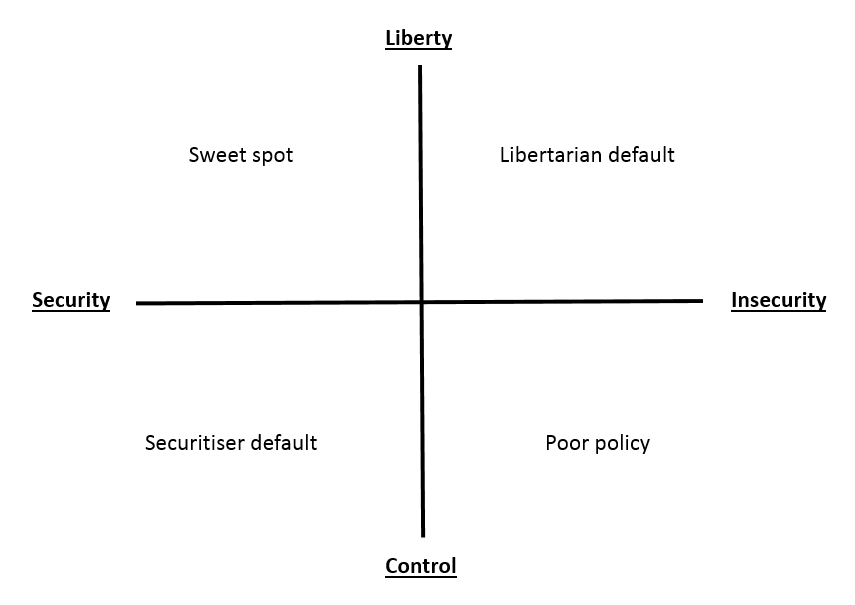Editors’ picks for 2014 ‘Security and liberty: a schematic’
Posted By Rod Lyon on December 26, 2014 @ 06:00
Originally published 9 September 2014.
In recent weeks, three of my colleagues have written about the appropriate balance that we should attempt to strike between national security and civil liberties. Toby Feakin began the series with a post [1] which argued that positioning security and liberty as opposite ends of a single spectrum, and then trying to find an appropriate balance point, was an inadequate way of thinking about the topic. Anthony Bergin replied [2] that striking some sort of balance between security and liberty was a practical necessity. And Andrew Davies argued [3] that having appropriate oversight mechanisms in place is a necessary condition for allowing secret state powers within a liberal democracy.
In this post, I want to explore the relationship between security and liberty. Stating the argument at its bluntest, I don’t find it helpful to think about security and liberty as the end points of a single spectrum. That’s because security and liberty aren’t polar opposites of each other. The opposite of security is insecurity. And the opposite of liberty is control. So if we want to explore the relationship between them, we should have a schematic that looks something like this:
Positing the relationship that way gives a better picture of what we’re trying to do. Ideally, as a liberal, democratic society, we’re trying to find security measures that land in the top left quadrant—the ‘sweet spot’—where we enhance our security in ways that accommodate our civil liberties. The core of our national discussion should be about that quadrant because it lets us have both liberty and security. We don’t trade them off against each other; we seek ways to achieve both simultaneously. Doing that isn’t easy; it involves debate and hard work—especially since security and transparency aren’t always compatible objectives.
A different problem begins once we reach proposed security measures that don’t fit the sweet spot quadrant, because then those who we might call ‘libertarians’ and ‘securitisers’ head in different directions. The libertarians—those who value liberty higher than security—default into the top right quadrant and tolerate a higher level of risk. The securitisers—those who value security higher than liberty—default into the bottom left quadrant and tolerate a lower level of liberty for the gain of feeling more secure. I’m uncertain who, if anyone, lives in the bottom right quadrant, though some might end up there temporarily and by accident.
The strength of the libertarian default position depends on the level of risk. The higher the risk becomes—say from a serious bird flu epidemic—the harder it is to argue that civil liberties can remain unconstrained. Several countries in West Africa are facing those sorts of challenges today in relation to the Ebola outbreak. Conversely, the strength of the securitiser default position depends on the existence of a clear and present danger—unless such a danger exists, democracies don’t usually tolerate stricter controls.
As a liberal, democratic society, Australia should be reluctant to trade away liberties for gains in security. Having a liberal society doesn’t usually require us to be unsafe: much can be done in the sweet-spot quadrant, especially when threats are clear. The bottom left quadrant is the natural home of authoritarian governments and dictatorships, who are typically unconcerned about civil liberties. It should require extraordinary dangers for us to venture there.
Still, extraordinary dangers do sometimes arise—dangers that force us to devise and impose security measures outside the comfort zone of the sweet spot. When they arise, the usual reaction of governments is to move towards the securitiser default position, and not towards the libertarian default position. Few governments respond to new threats by becoming more libertarian. But for a liberal democratic government, time spent in the securitiser default quadrant becomes a factor in its own right. ‘Emergency measures’ are for emergencies, after all, not for normalcy. The measure of a liberal democracy is how quickly it can shape those new protective measures to allow it to return to the sweet-spot zone.
I suspect all of my colleagues are actually having a discussion about three things: what we can and can’t do in the sweet-spot quadrant; when we should and shouldn’t contemplate alternative measures; and how we might qualify those measures to better protect our civil liberties. Seeing the security–liberty issue as a two-axes problem and not a single-axis one helps us sharpen both questions and answers.
Rod Lyon [5] is a fellow at ASPI and executive editor of The Strategist.
Article printed from The Strategist: https://aspistrategist.ru
URL to article: /editors-picks-for-2014-security-and-liberty-a-schematic/
URLs in this post:
[1] post: https://aspistrategist.ru/security-vs-civil-liberties-does-the-balance-model-do-us-justice/
[2] replied: https://aspistrategist.ru/reader-response-security-vs-civil-liberties/
[3] argued: https://aspistrategist.ru/national-security-and-civil-liberties/
[4] Image: https://aspistrategist.ru/wp-content/uploads/2014/09/Rod-image-2.png
[5] Rod Lyon: https://www.aspistrategist.ru/about-aspi/aspi-staff/fellows/rod-lyon
Click here to print.
